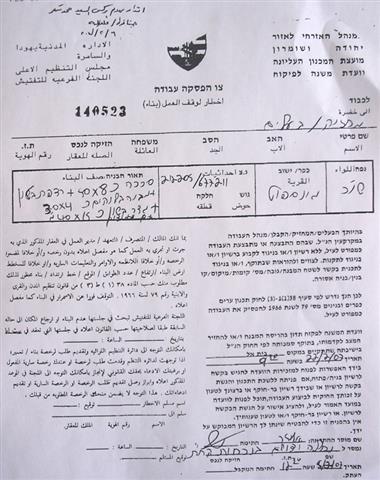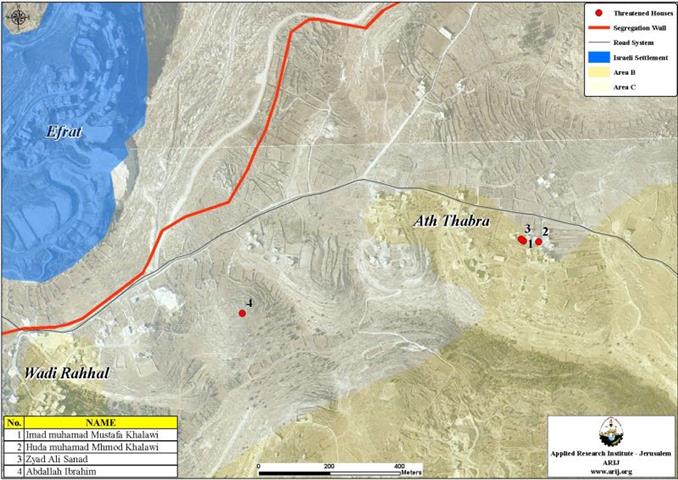The Israeli occupation authorities handed over two demolition notifications against agricultural installations in the village of Jinsafut, Qalqiliya governorate under the pretext of un-licensing. The notifications were handed over to brothers Sadeq and Mohammed Sukar on February 6th, 2007.
The two agricultural installations whose each has the total surface area of 800 square meters were built in the year 1997. They are used for poultry and sheep rearing. There was no previous warning whatsoever against the two installations which distance about 450 meters from the colonial road passing by the northern side of the village.
Photo 1 & 2: copies of the Israeli notifications for halting construction)
In an interview with LRC field worker, Mr. Sadeq Sukar said that the two threatened installations are the only source of living for the his family and his brother's family who totals 16 members of whom 9 are either school or university students. He went on to say that if these orders are implemented the two families will be financially ruined as the they will not be able to establish any other alternative project.
Location, Population and Area:
The village of Jinsafut, Qalqilia Governorate, is located 15 kilometers to the east of the city of Qalqilia. Its population is about 2,500 Palestinians. About 78% of the population used to depend on working in Israel and in the agricultural sector. Yet, due to the deteriorating security situation during the recent Intifadat Al Aqsa, a large percentage of the population became unemployed. There are a number of families in the village including Al Ayoub, Al Sukar, Al Saber, Al Allan, Al Nassar and Al Basheer. The total area of the village is 8658 dunums of which 1248 is used for building purposes.
Map 1: location of Jinsafut and Wall path
Legal action
Immediately after receiving the warnings, the owners started to prepare all the documents necessary to defend their threatened structures, including land registration certificates and land surveying. However, the Israeli ' civil administration' at Beit El refused to acceptthe documents and put more obstacle on the way such as obtaining a land taboo ( decree) which is impossible to get as the whole land in Qalqiliya area has not taboo.
Previous notifications
During the course of the last year the Israeli occupation authorities distributed 9 notifications calling on owners to halt construction in their premises which include: 2 houses, 6 agricultural and small workshop installations and 1 cistern. All the notifications were issued on the pretext of un-licensing.
Mr. Ahmad Abdul Rahman, a father of 9, is one of the owners who had received such a notification last September. His house is located only 15 meters out of the borders of the village's built up area.
Zone C: deducted at the expense of planning schemes
The Israeli occupation authorities preceded the Olso agreement in 1993 with the announcement of planning schemes for all the Palestinian cities, towns and villages in the West Bank in which it unilaterally drew up the borders of the built up areas for each Palestinian residential area based upon Israeli needs and greed. That is, all the Israeli – announced Palestinian built up schemes were limited to certain areas under the names of zone A and B and the remaining lands were announced as zone C which remained under total Israeli control. The reason behind this policy was to name as much land as possible under zone C before going into talks with the Palestinian side.
As a direct effect of this policy many villages and towns has lost most of their lands to zone C where Palestinians are not allowed to get any construction on these lands. The village of Jinsafut is a typical example. All of the threatened structures are located in zone C outside the borders of the Israeli imposed built up area of 1248 dunums (one dunum equals 1000 M2) out of 8658 dunums the total surface land area of Jinsafut.
This situation has put the owners and inhabitants of these houses in constant fear as Mr. Mohammed Amin Subhi, one of the owners, had said to LRC field worker: ' I have been living in a nightmare since I received the notification form from the Israeli side seven months ago. I hate to see any bulldozer around as I imagine it coming to demolish my house which I built with all the money I had earned. This feeling of insecurity is very bad for me and my family'.
The owners of the threatened houses were forced to build in zone C since they own no land within the Israeli announced planning scheme and they couldn't afford to buy, especially after the sharp increase on land prices because of the limited space for construction in compliance with the Israeli imposed scheme.
In related development, the Israeli occupation authorities on February 7th, 2007, warned the Jinsafut municipality to stop asphalting local roads inside the village under the pretext of un-licensing although the roads were opened during the seventies of the last century.
Prepared by
The Land Research Center
LRC

















